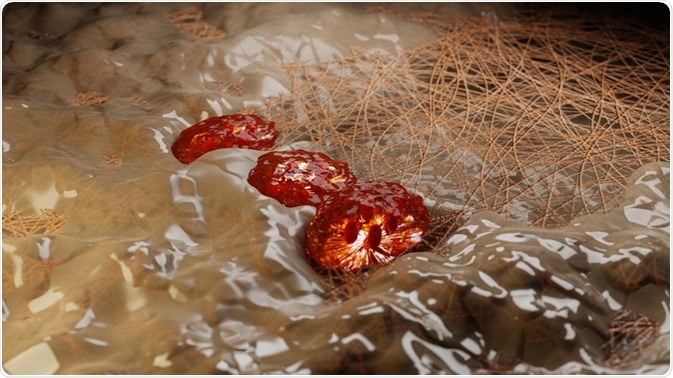From paper cuts to major wounds, many bodily tissues have the capability to heal after trauma or injury. Although this is something we may take for granted, the mechanism through which tissues can heal themselves is a complex one that is still not fully understood. Understanding tissue repair and regeneration is key to developing therapies to aid those with healing disorders, as well as potentially developing an alternative to transplantation for those with organ damage.

Bone Remodeling. Image Credit: ALIOUI MA/Shutterstock.com
Although originally believed to be a continuum, it is now widely believed that regenerative events can be separated into three distinct categories: tissue repair, tissue regeneration, and tissue replacement.
Tissue replacement
Tissue replacement occurs in two primary scenarios. The first is when the injury occurs in a tissue in which the cells are in a non-diving state and are therefore not capable of repair, for example, cardiac tissue. The second scenario is when the injury is too severe to be repaired. Instead, the damaged tissue is replaced by fibrous connective tissue, resulting in a scar that does not function in the same way as the undamaged tissue.
Tissue Repair
Tissue repair refers to the restoration of tissue structure and function after injury. This can be broken down into three major processes: inflammation, proliferation, and remodeling. Although typically modeled in the context of a skin injury, the underlying process is similar for most tissue repair events.
Tissue Injury and Repair Tissue Regeneration and Healing
Inflammation
At the site of injury, blood leaking from compromised blood vessels undergoes coagulation, activated by exposed collagen. The coagulation cascade promotes the formation of a fibrin network on which platelets aggregate, forming a plug that prevents both further bleeding and infection by microorganisms. Platelets release various pro-inflammatory cytokines, which recruit neutrophils and other leukocytes to the site of the wound.
Leukocytes destroy any invading pathogens, as well as breaking down any remaining damaged tissue and debris. This typically occurs within the first 24 hours of injury. After around 48 hours, there is increased differentiation of macrophages, which release growth factors necessary to transition to the proliferative stage of repair.
Proliferation
The proliferative phase begins with angiogenesis, a complex process in which growth factors and integrins promote the development of new blood vessels, reaching peak vascularity around 5 days post-injury. Around the same time, granulation tissue is formed through the proliferation of fibroblasts, synthesis of collagen and elastic fibers, and increased cytokine production from fibroblasts.
Another key feature of the proliferation phase is the contraction of the wound itself and the regrowth of the epithelium. Myofibroblasts in the smooth muscle contract to minimize the wound area and reduce the area to be rebuilt. Fibroblasts secrete collagen at the periphery of the wound, which combines with fibrin and fibronectin to provide a framework on which new epithelial cells can be built. Reepithelialization occurs when epithelial cells proliferate and migrate over the fibronectin framework, bridging the wound area.
Proliferation is key to tissue repair and requires cells to enter the cell cycle and divide, hence why non-dividing tissues are not able to undergo tissue repair.
Remodeling
Around two weeks after injury, leukocytes begin to leave the wound area, and dilated blood vessels recede. Granulation tissue is remodeled to scar tissue consisting of fibroblasts, collagen, and elastic tissue. As the fibroblasts begin to leave, the wound is bridged by an acellular scar and a new intact epidermis. To reach maximum strength, new, thicker collagen fibers are organized in parallel. Contraction of the tissue surrounding the scar can continue to happen for several years, reducing the scar area.
Tissue Regeneration
Tissue regeneration can be considered to be a step further than tissue repair, in which the new growth completely restores both the function and complex structure of the tissue to the pre-injury or ‘normal’ state.
In order to undergo true regeneration, the cells within a tissue must have proliferative capabilities and the framework underlying the tissues must not be damaged. In continuously dividing tissues, regeneration is always occurring as older cells are replaced by newer ones.
Despite this, tissue injury is rarely followed by true tissue regeneration. In reality, the majority of non-superficial wound healing events in mammals involve a combination of both tissue repair and replacement, with some degree of scarring.
Therapeutic applications
There has long been great interest in the tissue repair process. Understanding the molecular process of tissue repair could lead to significant advances in helping those who have reduced healing capacity, for example, diabetic patients. Improving the healing process in these patients could greatly improve the quality of life for those with chronic wounds, and even reduce mortality rates for severe injuries.
As well as developing therapies to aid those who display compromised tissue repair, there has recently been a significant increase in tissue repair and regeneration research with a focus on the immune response. Although tissue regeneration is uncommon in mammals, some vertebrates (such as the salamander) are capable of true tissue regeneration and even regrow entire limbs after amputation.
It has been suggested that this reduced capacity for tissue regeneration in mammals could be due to a more complex immune system. Elucidating the mechanisms through which this occurs (and those that prevent it in humans) could hold the key to revolutionizing regenerative therapies.
Sources:
- Emings, SA., Martin, P., Tomic-Canic, M. (2014). Wound repair and regeneration: mechanisms, signalling, and translation. Science translational medicine, 6(265). https://doi.org/10.1126/scitranslmed.3009337
- Gonzales, AC., Costa, TF., Andrade, ZA., Medrado, AR. (2016). Would healing- A literature review. Anais brasileiros de dermatologia, 91(5), 614-620. https://doi.org/10.1590%2Fabd1806-4841.20164741
- Krafts, KP. (2010). Tissue repair: The hidden drama. Organogenesis, 6(4), 225-233. https://doi.org/10.4161/org.6.4.12555
Further Reading
Last Updated: Nov 4, 2024